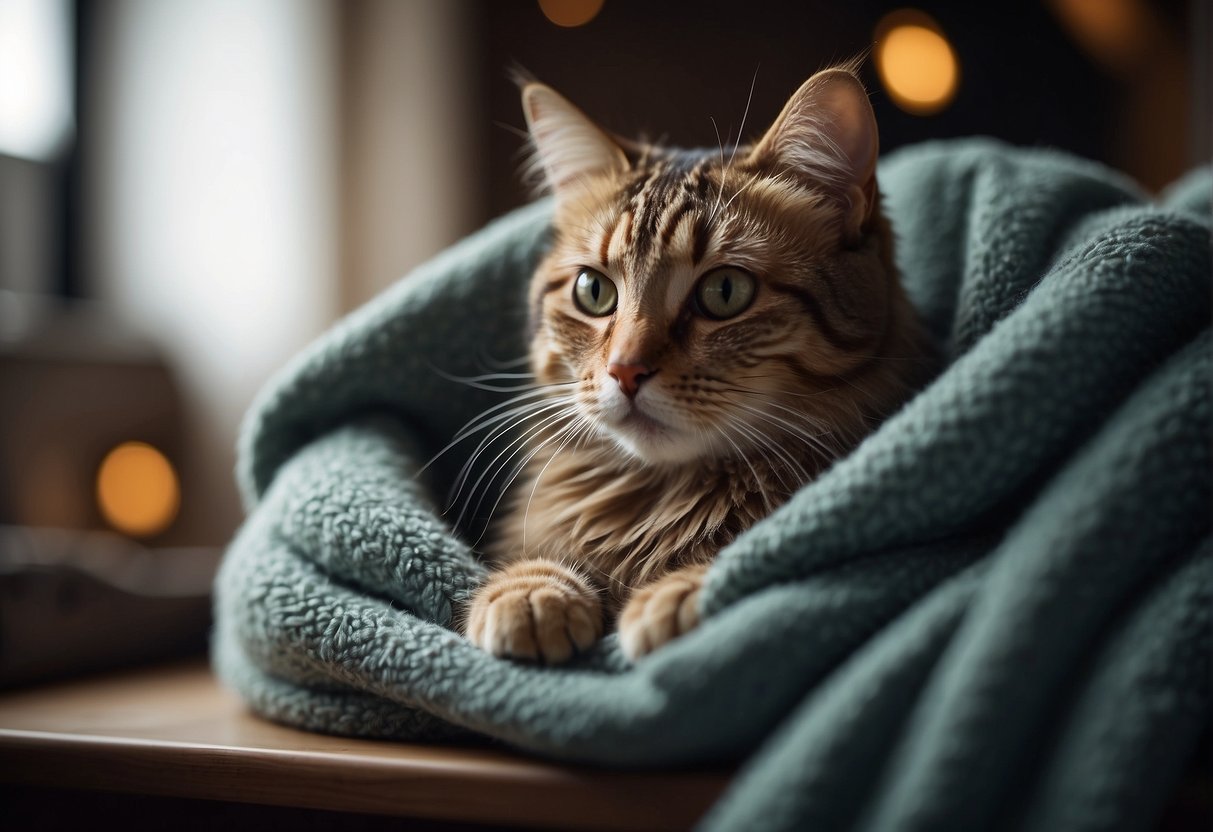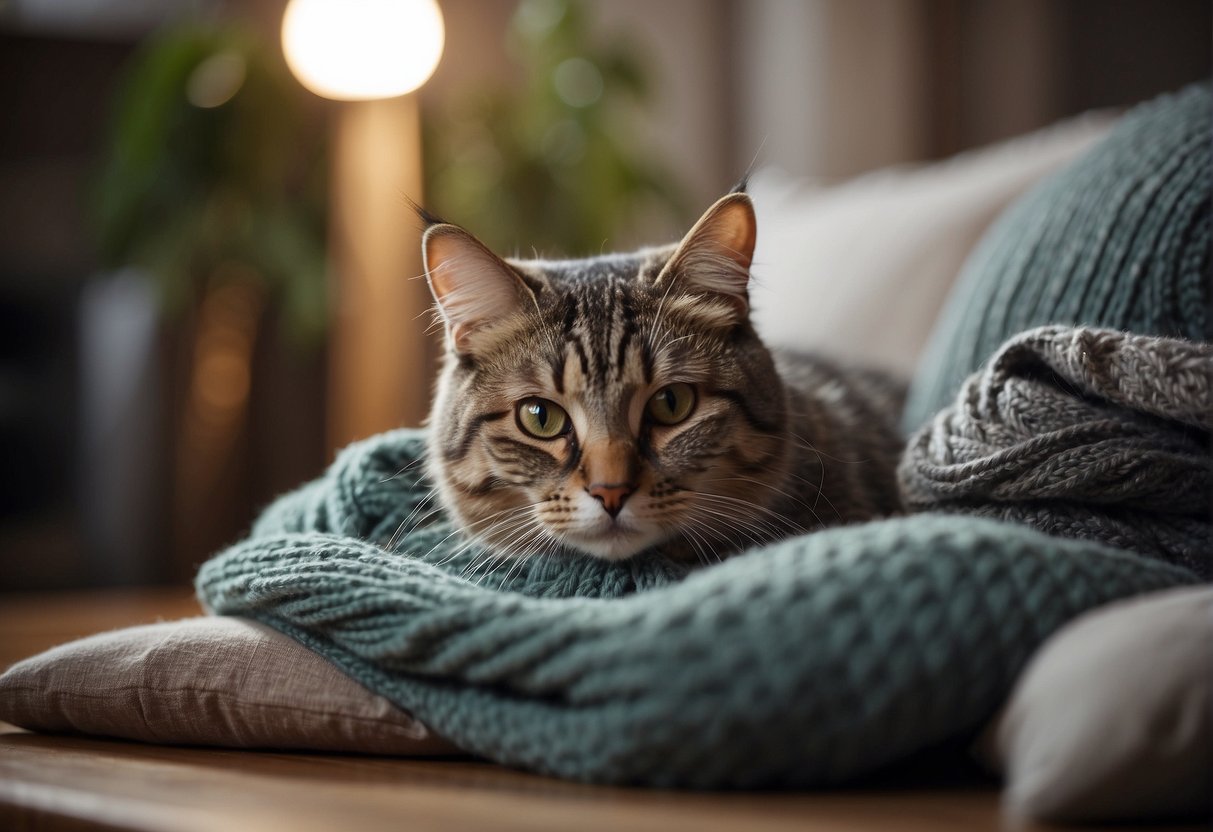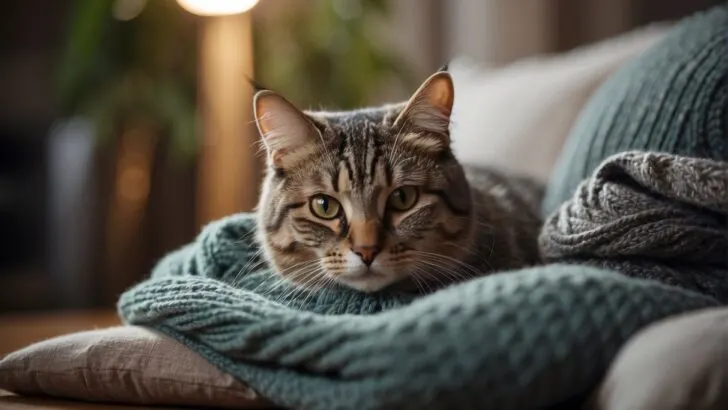Cats exhibit nesting behavior as a natural instinct to create a safe and secure place for rest and, if they’re expecting, for giving birth to and caring for their kittens. You might notice this behavior when your cat starts seeking out secluded spots—like a quiet corner in a closet or a cozy nook under a bed.
These are prime examples of locations where your feline friend may feel most comfortable to let her guard down and relax, or deliver a litter in a protective environment.

Knowing your cat’s need for nesting is key to providing the best care, particularly if she’s pregnant. As the time for birthing approaches, this behavior becomes more pronounced.
Your cat may gather soft materials, like blankets or clothing, to create a comfortable spot, or she may prefer an empty box or a special nesting area you set up in a quiet part of your home. It’s their way of ensuring they have a controlled, private space.
Nesting can also be a cozy routine for your cat’s daily life, not just for pregnancy. It’s a sign of their remarkable instinct to control their environment, which provides them emotional comfort and security. Observing these behaviors in non-pregnant cats is quite common as well.
How Cats Go About Nesting

Nesting is an intriguing behavior displayed by cats, often linked to their need for comfort, security, and instinctual habits.
The Roots of Feline Nesting Behavior
Cats inherit nesting instincts from their wild ancestors, where securely hiding their offspring from predators was crucial for survival. For your indoor cat, this behavior has adapted into seeking out cozy spots for relaxation, away from the hustle of daily life, which also eases stress or anxiety.
Although all cats can exhibit nesting, it becomes particularly significant when a female cat is preparing to give birth, reflecting their search for a safe birth environment.
Physical and Behavioral Signs of Nesting
When your cat is nearing the end of her pregnancy, you may notice distinct signs indicative of nesting:
- Increased Affection or Seclusion: She may become more affectionate, seeking your presence for security or, conversely, she might withdraw to quiet, undisturbed areas.
- Appetite Changes: Expect fluctuations with an increased appetite initially, potentially followed by a loss of appetite as labor approaches.
- Preparation Activities: Your cat may start to gather soft materials, choose secluded spots, or become busier in arranging her space.
- Lethargy: As the time nears, she might seem more tired and less interested in regular activities.
The Role of Pheromones and Comfort in Nesting
Pheromones play an essential role in nesting. Cats will often choose a spot and mark it with their scent to signal it as their territory. This act of leaving pheromones provides both a sense of comfort to the cat and establishes that area as their personal space.
Whether it’s a quiet corner, a cardboard box, or a specially prepared nesting box, your cat will seek a spot that offers the serenity and warmth needed for the vulnerable period of giving birth and raising kittens.
By providing soft blankets or a safe nesting box, and keeping the home environment calm, you can help your feline friend feel secure.
Preparing for Birth
Preparing for the birth of kittens is a pivotal moment. Your pregnant cat’s comfort and safety are paramount, and understanding the ideal nesting materials and recognizing the stages of labor can ensure a smoother birthing process.
Nesting Materials and Locations
When your cat is preparing to give birth, she’ll instinctively seek a secure and comfortable spot. Your role is to provide her with a nesting area that’s warm, quiet, and free from drafts.
A cozy nesting box, lined with soft materials such as clean towels, blankets, or old shirts, will provide the necessary comfort. It’s best to choose items that can be easily replaced or washed, as birthing can be messy.
Location is equally important. The nesting box should be in a peaceful part of your home where there’s little foot traffic and minimal noise. This helps your cat feel safe to engage in nesting behavior without stress. A secluded corner or a closet can often serve as the perfect spot for this intimate moment.
- Bedding: Soft, washable materials.
- Warmth: Ensure the area is warm but well-ventilated.
- Privacy: A quiet, undisturbed location is ideal.
The Stages of Labor in Cats
Cats experience several stages of labor, and recognizing these signs can help you provide the necessary support. The first stage involves nesting and restlessness. Your cat may pace, vocalize, or even groom incessantly. It’s your cue to ensure she has everything she needs for comfort.
The second stage is the onset of active labor, signaled by visible contractions and the appearance of the amniotic sac. It’s natural to feel anxious, but staying calm is key. Cats are generally very self-sufficient during labor, but do keep an eye out for signs of distress.
In the third stage, your cat will deliver her kittens. Each kitten typically arrives wrapped in a birth sac, and the mother will lick the sac away to help the kitten breathe. It’s normal for kittens to arrive at intervals, so patience is necessary.
Remember, every pregnancy in cats is unique, and while many cats will handle giving birth with relative ease, complications can occur.
Caring for a Nesting Cat
When your cat begins to display nesting behavior, it’s a sign that she’s seeking a safe and comfortable environment.
How Cat Owners Can Support Nesting Behavior
Your cat’s search for the perfect nesting spot is an instinctual process. As a cat owner, it’s your job to facilitate this by providing warm and cozy spots. Offer several options around your home to encourage her innate nesting behavior.
You might use soft blankets or a dedicated nesting box lined with clean towels. Observe where your cat seems to settle most often and make that space as inviting as possible.
Managing Stress and Providing Security
Nesting is a time when your cat needs to feel secure and protected from stress. Maintaining a quiet atmosphere away from the hustle and bustle of the household can promote stress relief.
Pay attention to her cues; if she retreats to her chosen spot, minimize disturbances. Security translates to comfort for your feline, and a proactive approach in creating a serene environment can make all the difference.
The Importance of Neutering and Responsible Breeding
If you’re not a professional breeder, consider neutering your male cat to prevent any unintended litters and reduce stress on your female cat. If your cat is nesting because she’s pregnant, it underscores the importance of responsible breeding.

My name is James, and welcome to FAQCats!
Along with our team of cat owners, expert pet enthusiasts, and pet professionals, we aim to write engaging helpful, engaging content about cats. At FAQCats we strive to provide content that’s accurate and fun to read. Our team writes about everything related to cats; even the most complex of topics. Through extensive research and caring for our own fur-pals, we’re able to provide something cat owners worldwide will love. Have a look around, and leave us feedback anytime!

